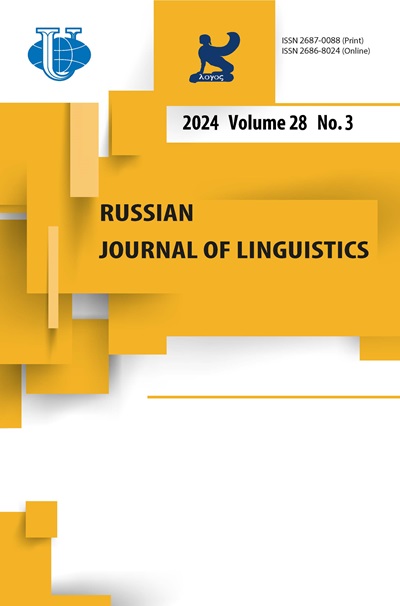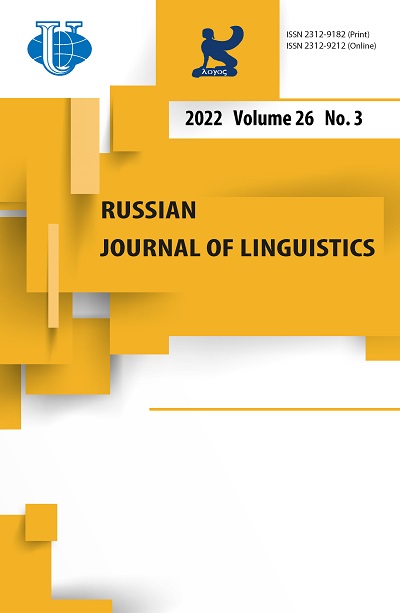Семиотический портрет большого китайского города
- Авторы: Леонтович О.А.1, Котельникова Н.Н.1
-
Учреждения:
- Волгоградский государственный социально-педагогический университет
- Выпуск: Том 26, № 3 (2022)
- Страницы: 701-720
- Раздел: Статьи
- URL: https://journals.rudn.ru/linguistics/article/view/32091
- DOI: https://doi.org/10.22363/2687-0088-31228
Цитировать
Полный текст
Аннотация
Медиаурбанистика - стремительно развивающаяся сфера исследований, направленная на выявление закономерностей коммуникации в урбанистическом контексте. Цель настоящего исследования - анализ семиотики большого китайского города как сложной коммуникативной системы и ее воздействия на динамику городского социума. Практический материал включает более 700 единиц (топонимы, рекламные объявления, плакаты, афиши, мемориалы, сообщения в местных СМИ, названия и оформление местной еды, сувениры, популярные коммуникативные практики и т. д.), собранных в Тяньцзине, одном из крупнейших китайских городов с населением около 14 млн человек. В качестве ключевых методов исследования выступают критический дискурс-анализ, этнографический и семиотический методы, а также нарративный анализ. В процессе исследования раскрыты структура коммуникации в большом китайском городе и закономерности интеграции языка в городской контекст. Выявлено, что историческая память представлена в виде мемориалов, символов, исторических и современных нарративов. Физический контекст ассоциируется с наименованиями улиц и других топологических объектов. Языковые и визуальные семиотические знаки применяются для обеспечения психологической и физической безопасности. Социальная реклама преимущественно используется для пропаганды китайской официальной политики, традиционных ценностей и цивилизованного поведения. Городские субкультуры, такие как «муравьиное племя», «люди-маятники», «шаматэ» и др., отражают новую социальную реальность. Гастрономический дискурс ассоциируется с культурными ценностями и различными аспектами социальной идентичности. На облик большого китайского города также влияют глобализационные тенденции и пандемия коронавируса. Разработанная концепция позволяет представить широкую панораму современной городской жизни и может быть экстраполирована на исследование языкового ландшафта других крупных городов.
Ключевые слова
Об авторах
Ольга Аркадьевна Леонтович
Волгоградский государственный социально-педагогический университет
Автор, ответственный за переписку.
Email: olgaleo@list.ru
ORCID iD: 0000-0002-0972-4609
доктор филологических наук, профессор кафедры межкультурной коммуникации и перевода
Волгоград, РоссияНадежда Николаевна Котельникова
Волгоградский государственный социально-педагогический университет
Email: kotelnikova_n_n@yahoo.com
ORCID iD: 0000-0001-9900-1983
кандидат педагогических наук, заведующая кафедрой межкультурной коммуникации и перевода, директор Института Конфуция
Волгоград, РоссияСписок литературы
- Aiello, Giorgia & Simone Tosoni. 2016. Urban communication. Going about the city: Methods and methodologies for urban communication research - Introduction. International Journal of Communication 10. 1252-1262
- Bakumova, Elena & Nadezhda Kotelnikova. 2019. Linguistic Expression of the Social Stratification of Chinese Urban Society. SHS Web of Conferences (The International Scientific and Practical Conference “Current Issues of Linguistics and Didactics: The Interdisciplinary Approach in Humanities and Social Sciences”) 69. https://doi.org/10.1051/shsconf/20196900011
- Baranova, Vlada & Kapitolina Fedorova. 2017. (In)visibility and (non)existence: Labor migrants and the St. Petersburg linguistic landscape. Gorodskie Issledovaniya i Praktiki 2 (1). 103-121. (In Russ.)
- Bazilevich, Mikhail. 2017. Russian marks in the architecture of Tianjin. Arkhitekton: Izvestiya Vuzov 4 (60). 91-102. (In Russ.)
- Blommaert, Jan. 2005. Discourse. A Critical Introduction. Cambridge: Cambridge University Press.
- Bryman, Alan. 2008. Social Research Methods. Oxford, New York: Third ed. Oxford University Press.
- Burr, Vivien. 1995. Introduction to Social Constructionism. London, New York.
- Chen, Fachin & Olga Leontovich. 2020. A tale of two cities: Historical narratives in the Russian and Chinese urban landscapes. Science Journal of VolSU. Linguistics 19 (2). 78-85.
- Defining small data. Small Data Group. https://smalldatagroup.com/2013/10/18/defining-small-data/
- Dickinson, Greg & Giorgia Aiello. 2016. Urban communication. Being through there matters: Materiality, bodies, and movement in urban communication research. International Journal of Communication 10. 1294-1308
- Doroshkina, Kristina & Elena Stekhova. 2018. The picture of Russian cities in China. Arkhitektura i Dizain: Istoriya, Teoriya, Innovatsii 3. 38-44. (In Russ.)
- Hutchison, Ray (ed.). 2010. Encyclopedia of Urban Studies. Two-volume set. Green Bay, USA, University of Wisconsin. https://dx.doi.org/10.4135/9781412971973
- Fairclough, Norman. 2003. Analysing Discourse. New York: Routledge.
- Fornäs, Johan. 2006. Introducing media cities. The ESF-LiU Conference Cities and Media: Cultural Perspectives on Urban Identities in a Mediatized World. Vadstena, Sweden, 25-29 October. 5-19
- Foucault, Michel. 1977. Discipline and Punish. Harmondsworth: Penguin
- Gorter, Durk. 2006. Introduction. The study of linguistic landscape as a new approach to multilingualism. International Journal of Multilinguilism 3. 1-6
- Kvyat, Alexandra. 2013. New communication practices in Russian cities. Razvitie russkoyazychnogo mediaprostranstva: kommunikatsionnye i eticheskie problemy. Materialy Mezhdunarodnoi nauchno-prakticheskoi konferentsii. Moscow: Academia. 351-360. (In Russ.)
- Kvyat, Alexandra. 2014. Anti-cafes, food markets, and pop-up parks: The postvirtual city in Russia. Science Journal of VolSU. Linguistics 7 (23). 126-134. (In Russ.)
- Laundry, Rodrigue & Richard Bourhis. 1997. Linguistic landscape and ethnolinguistic vitality: An empirical study. Journal of Language and Social Psychology 16 (1). 24-49.
- Lefebvre, Henri. 1991. The Production of Space. Malden, MA: Blackwell (Original work published in 1974).
- Leontovich, Olga & Nadezhda Kotelnikova. 2021.The nature of Chinese and Russian subcultures in urban discourse. Science Journal of VolSU. Linguistics 20 (5). 87-96.
- Leontovich, Olga. 2018. The all-seeing eye of the city from the perspective of urban communication studies. Science Journal of VolSU. Linguistics 17 (4). 206-213.
- Leontovich, Olga. 2019. New forms of urban discourse as a reflection of social сhange. Kommunikativnye issledovaniya 3. 645-654.
- Leontovich, Olga. 2020a. Language of a big city: Key problems of urban communication studies. Etnopsikholingvistika 3. 19-34. (In Russ.)
- Leontovich, Olga. 2020b. The problem of social visibility from the perspective of urban communication studies. Vestnik of Moscow State Linguistic University. Humanities 12 (841). 99-111. (In Russ.)
- Li, Delin. 2018. Chengshi huanjing wuran yu zhili cuoshi yanjiu [Urban Environmental Pollution and Control Measures]. Gongye B 1. 287. (In Chin.)
- Liu, Lili. 2013. “Xiao qingxin” fengge de yawenhua jiedu [A subcultural interpretation of the “xiaoqingxin” style]. Yishu bai jia 1. 71-73. (In Chin.)
- Liu, Xiang. 2014. “Feitezu” de guang yu ying [The light and shadow of “Feitezu”]. Gaozhongsheng: Zhi jiao yu jiuye 7. 16-17. (In Chin.)
- Lotman, Yurii. 1992. Symbols of St. Petersburg and Problems of Urban Semiotics. Selected Articles 2. Tallinn: Aleksandra. 9-21. (In Russ.)
- Low, Kelvin E. Y. & Devorah Kalekin-Fishman. 2019. Senses in Cities. Experiences of Urban Settings. 1st edition. New York: Routledge.
- Mellor, Julia R. 1977. Urban Sociology in an Urbanized Society. London: Routledge & Kegan Paul.
- Parker, Simon. 2015. Urban Theory and the Urban Experience. Encountering the City. Routledge.
- Pavlenko, Aneta. 2017. Linguistic landscape and other sociolinguistic methods in the study of Russian language abroad. Russian Journal of Linguistics 21 (3.) 493-514. https://doi.org/10.22363/2312-9182-2017-21-3-493-514
- Pearce, W. Barnett. 1994. Interpersonal Communication: Creating Social Worlds. New York: Harpercollins College Div
- Pütz, Martin. 2020. Exploring the linguistic landscape of Cameroon: Reflections on language policy and ideology. Russian Journal of Linguistics 24 (2). 294-324. https://doi.org/10.22363/2687-0088-2020-24-2-294-324
- Pütz, Martin & Neele Mundt. 2019. Multilingualism, multimodality and methodology: Linguistic landscape research in the context of assemblages, ideologies and (in)visibility: An introduction. In Martin Pütz & Neele Mundt (eds.), Expanding linguistic landscape: Linguistic diversity, multimodality and the use of space as a semiotic resource, 1-24. Bristol: Multilingual Matters
- Scollon, Ron & Suzie Wong Scollon. 2003. Discourses in Place: Language in the Material World. London/New York: Routledge.
- Simmel, Georg. 1950. Metropolis and mental life. In K. H. Wolff (ed.), Sociology of Georg Simmel. Chicago: Free Press. (Original work published in 1903).
- Spector, Malcolm & John I. Kitsuse. 1977. Constructing Social Problems. Menlo Park, CA, Cummings.
- Wang, Fushuai & Yang Yang. 2014. Reflection on the Phenomenon of “Shamate”. Qingnian yu shehui 5. 336-337. (In Chin.)
- Wang, Sini. 2010. Analysis of the new network word “X Zu”. Beifang Wenxue 11. 87-88. (In Chin.)
- Weber, Max. 1927. General Economic History. London: Allen & Unnwin (Original work published in 1923).
- Weber, Max. 1978. The city (non-legitimate domination). In Max Weber, Guenther Roth & Claus Wittich (eds.), Economy and Society: An Outline of Interpretive Sociology, 1212-1372. Berkeley: University of California Press. 2. (Original work published in 1922)
- Wu, Yao. 2017. Comparative analysis of the social structures of Russia and China. Obshchestvo: Sotsiologiya, Psikhologiya, Pedagogika 5. 57-60. (In Russ.)
- Xiao, Yaoyao. 2009. “Zu” lei hanyu xin ci yufahua qianxi [Grammatical analysis of the Chinese neologisms with morpheme “Family”]. Zhongzhou Daxue Xuebao 2. 75-77. (In Chin.)
- Yelenevskaya, Maria & Larisa Fialkova. 2017. Linguistic landscape and what it tells us about the integration of the Russian language into Israeli economy. Russian Journal of Linguistics 21 (3). 557-586. https://doi.org/10.22363/2312-9182-2017-21-3-557-586
- Zeng, Dan. 2010. Shi xi xin ciyu “zhongbai zu” [The analysis of neologism “Pendulum clan”]. Xiandai yuwen (yuyan yanjiu ban) 11. 147-148. (In Chin.)
- Zhao, Shengkui. 2014. “Yi zu” shehui ziben de queshi yu jiangju [The Construction of Social Capital of “Ant tribe”]. Hebei qingnian guanli ganbu xueyuan xuebao 6. 7-11. (In Chin.)
- Zheng, Shaocheng & Xu Yuanyuan. 2017. Chengshi huanjing wuran yu zhili duice [Environmental pollution in cities and countermeasures]. Gongcheng jishu (Yinwen ban) 2. 91. (In Chin.)
- nian quanguo nongcun liushou ertong shuliang 902 wan [In 2018 the number of abandoned children in rural areas all over the country was 9,02 mln.]. Gaokao zhishi wang http://www.xjdkctz.com/jiaoyu/xiaoxue/653194.html. (In Chin.)
- Li, Delin. 2018. Urban Environmental Pollution and Control Measures. Gongye B 1. 287. (In Chin.)
- Zheng, Shaocheng & Xu Yuanyuan. 2017. Environmental pollution in cities and countermeasures. Gongcheng jishu (Yinwen ban) 2. 91. (In Chin.)

















